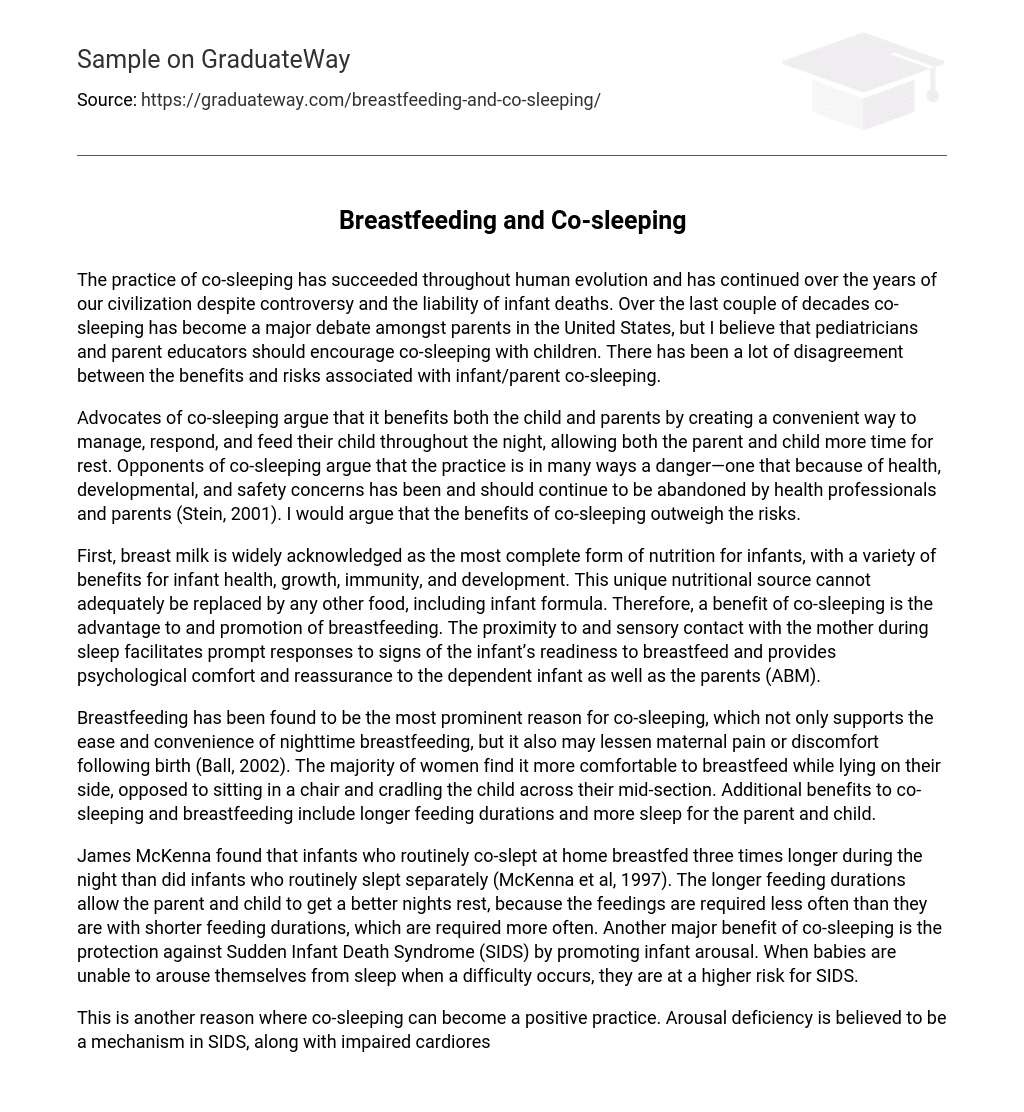Despite ongoing debates and incidents of infant deaths, co-sleeping has been a prevalent practice throughout human history. In the United States, it continues to be a divisive topic among parents. Nevertheless, I maintain that pediatricians and parent educators should advocate for and endorse co-sleeping with children. The benefits and drawbacks of infants sleeping alongside their parents have sparked substantial discourse and dissent.
Supporters of co-sleeping argue that it offers benefits for both parents and children, including a convenient way to attend to the child’s nighttime needs and improve sleep. On the other hand, opponents argue that co-sleeping poses risks related to health, development, and safety. Nevertheless, I believe that the advantages of co-sleeping outweigh the potential dangers (Stein, 2001).
Breast milk is the ultimate source of nutrition for babies, providing numerous benefits for their health, growth, immunity, and development. There is no alternative food like infant formula that can compare to this exceptional nutritional source. As a result, co-sleeping supports breastfeeding by promoting close contact between the mother and baby during sleep. This proximity enables the mother to swiftly respond to cues indicating the baby’s readiness to breastfeed. Additionally, it offers psychological comfort and reassurance for both the dependent infant and parents (ABM).
Co-sleeping is frequently motivated by the need for convenient nighttime breastfeeding and can also alleviate postpartum discomfort (Ball, 2002). Numerous mothers opt to nurse their infants while reclining on their side as opposed to sitting upright with the baby positioned across their abdomen. Co-sleeping and breastfeeding offer added benefits like extended feeding sessions and enhanced sleep for both parent and child.
According to a study by James McKenna, infants who slept with their parents had longer nighttime breastfeeding sessions compared to those who slept separately (McKenna et al, 1997). This extended period of breastfeeding benefits both the parent and child as it allows for more sleep due to fewer feedings. Furthermore, co-sleeping helps prevent Sudden Infant Death Syndrome (SIDS) by promoting infant arousal during sleep. Infants who are unable to wake themselves have a higher risk of experiencing SIDS.
Co-sleeping can be viewed as a positive practice for several reasons, including addressing arousal deficiency in SIDS. A hypothesis suggests that diminished arousability during stage 3-4 sleep (deep sleep) may explain the mechanism of SIDS, along with impaired cardiorespiratory control, hyperthermia, and rebreathing of carbon dioxide in bedding. Sarah Mosko’s findings on infant arousal propose that the alterations in stage 3-4 sleep and arousals linked to bed sharing could potentially safeguard at-risk infants from SIDS due to a presumed arousal deficit.
The research conducted by Mosko et al. (1997) suggests that co-sleeping, or parents sleeping in the same bed as their infants, can protect against Sudden Infant Death Syndrome (SIDS) by increasing the mother’s responsiveness to the baby’s arousal. Personally, I believe that co-sleeping increases parental awareness and allows for easy monitoring of infants at night, reducing the risk of SIDS. Additionally, Crawford (1994) states that co-sleeping has long-term advantages such as fostering confidence, self-esteem, and intimacy due to a feeling of parental acceptance. Furthermore, co-sleeping has been associated with more positive behavior and higher life satisfaction.
In a study conducted in U.S. cities, researchers examined five ethnic groups to determine the satisfaction levels of co-sleepers (Mosenkis, 1998). The results showed that co-sleepers expressed overall contentment with their lives. These long-term benefits further strengthen the argument for promoting co-sleeping and emphasizing its significant impact on an individual’s later development.
It is natural for parents to have concerns about co-sleeping because they do not want to risk harming their baby. The main worry associated with co-sleeping is the fear of infant asphyxiation.
It is possible that an unsafe environment can lead to accidental entrapment or an adult inadvertently lying on top of a child. I agree that co-sleeping raises safety concerns, but I believe these concerns can be resolved by educating individuals and promoting safe practices to create a secure setting. James McKenna proposes that with the right education and safe practices, co-sleeping can be considered a “healthy” choice (McKenna, 2005).
After ensuring a safe environment for their child, parents can focus on the numerous benefits of co-sleeping. In conclusion, by educating themselves and taking precautions to manage associated risks, I believe that the advantages of co-sleeping cannot be disregarded. When done safely, co-sleeping promotes positive development for both parents and children, as well as the entire family.
References:
-
McKenna, James (2005). Why babies should never sleep alone: A review of the co-sleeping controversy in relation to SIDS, bedsharing and breast feeding. Notre Dame, IN: University of Notre Dame.
-
Stein, M. (2001). Cosleeping (bedsharing) among infants and toddlers. Journal of Developmental and Behavioral Pediatrics, 22(Suppl.), S67-S71.
-
Mosko, S. S., Richard, C. A., McKenna, J. J. (1997). Infant Arousals During Mother-Infant Bed Sharing: Implications for Infant Sleep and Sudden Infant Death Syndrome Research. Pediatrics.
-
Morelli G.A., Rogoff B., Angelillo C., et al (1992). Cultural Variation in Infants’ Sleeping Arrangements: Question of Independence,
.
Developmental Psychology,,28(4),604-613 Ball,H.L.(2002)Reasons to bed-share; why parents sleep with their infants.Journal of Reproductiveand
.
Infant Psychology;20,207-221McKenna, J. J., Mosko, S. S. & Richard, C. A. (1997). Bedsharing promotes breastfeeding. Perdiatrics, 100, 214-219. Academy of Breastfeeding Medicine Protocol Committee (2008). ABM Clinical Protocol #6: Guideline on Co-Sleeping and Breastfeeding. Crawford, M. (1994). Parenting practices in the Basque country: Implications of infant and childhood sleeping location for personality development. Ethos, 22(1): 42-82. Mosenkis, J. (1998). The Effects of Childhood Cosleeping On Later Life Development. Master’s Thesis. University of Chicago, Department of Human Development.





